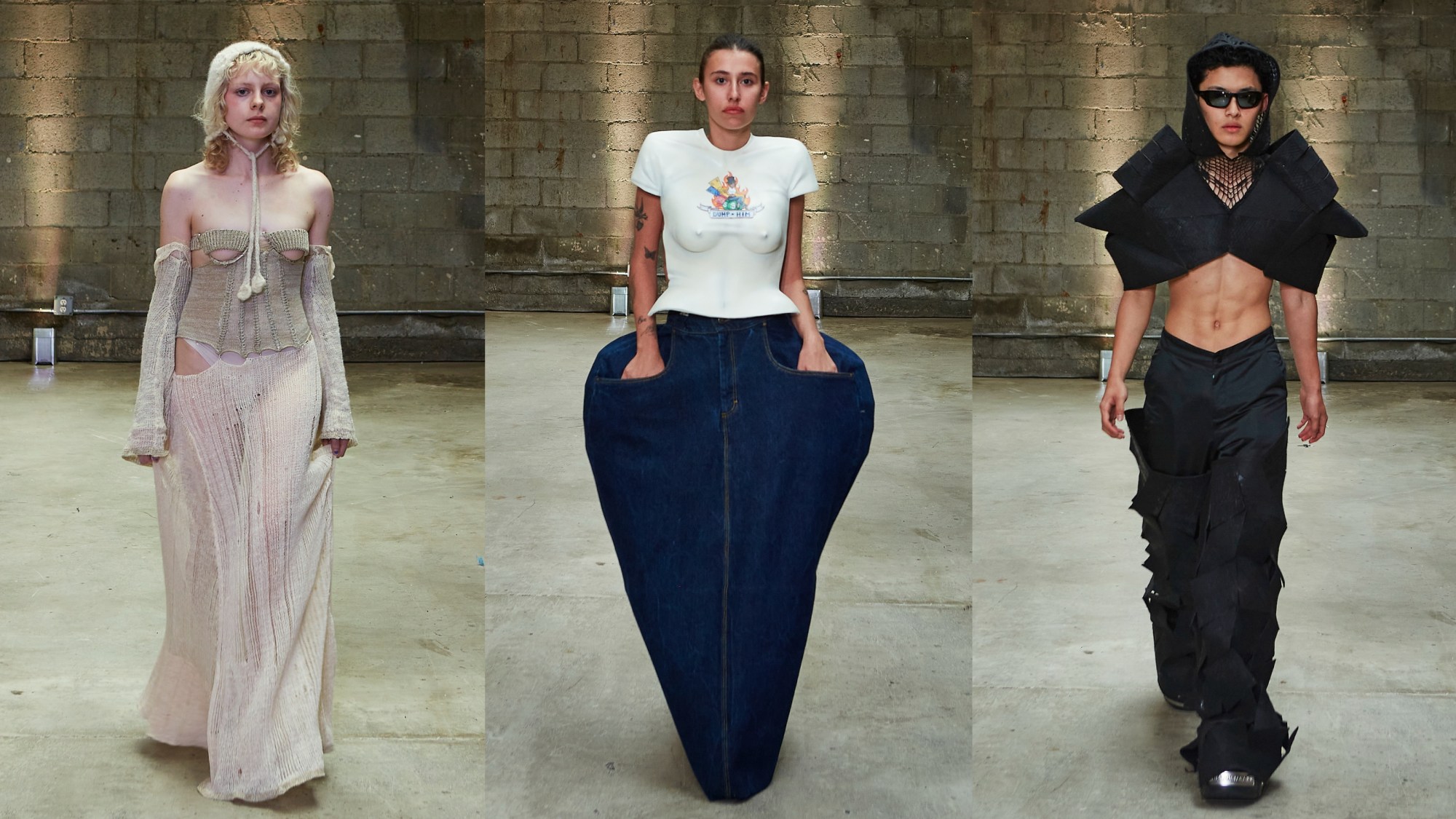Futuristic fantasy worlds, feelings of loneliness, sexual intimacy, environmental preservation and summer nostalgia are just a few of the themes Parsons’ BFA design students explored in their recent thesis collections. This year’s graduating class recently presented work that simultaneously pushed boundaries while embracing age-old design philosophies. Among the garments, knit sets fastened together with metal closures, a vest made from knotted silk paired with matching flared pants, a deconstructed leather jacket adorned with salvaged leather scraps, and a low-rise cotton skirt worn with a Victorian-inspired bustier proved that inventiveness and practicality can coexist. If there was one takeaway from their presentations, it’s that when it comes to originality and intention, a new cohort of experimental and ambitious designers are setting the bar high.
It’s no secret that New York school produces a plethora of talent that quickly rises in the ranks of fashion (Anna Sui, Marc Jacobs and Tom Ford are just a few highlights from this iconic alumni pool), and this class is no exception to the emerging talent Parsons continues to bring to the industry. The concepts behind the collections of this year’s class embrace sustainability, seek to preserve heritage design practices, demand gender inclusivity and embrace technology through computer generated works.
Below, we converse with a handful of standout Parsons BFA fashion design graduates to learn about their work, their influences and their hopes for the future.
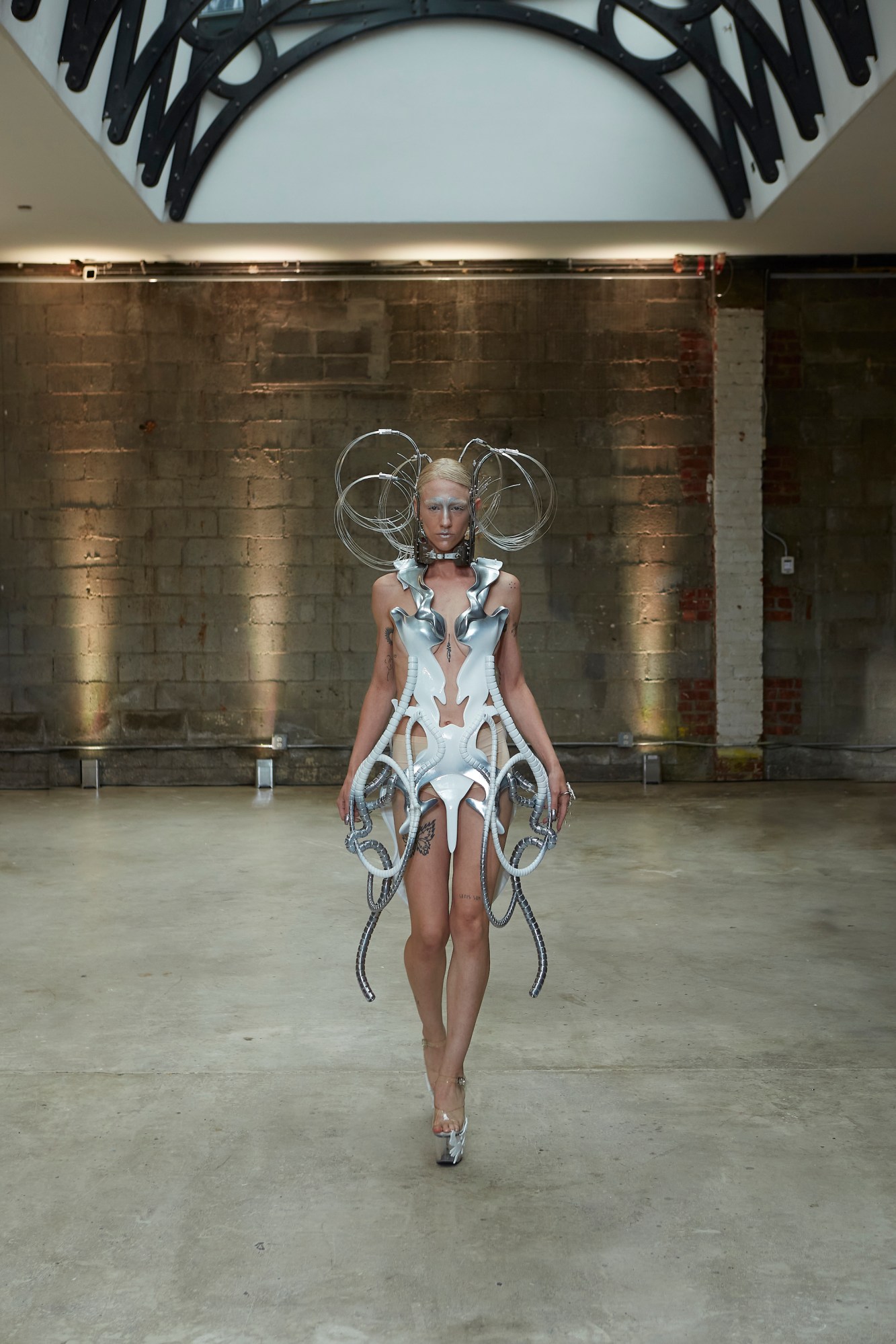
Yingying Chen
What about your collection excites you most?
The fusion of craftsmanship and technology. The integration of traditional techniques such as metalsmithing and machine knitting with contemporary technology like 3D printing and circuiting is incredibly exhilarating. This combination allows for the creation of unique and innovative designs that push the boundaries of what is possible in fashion.
What’s your favorite look and why?
My favorite look from the collection is the 3D-printed dress showcased in the runway show. It embodies the symbiosis of organic and mechanical elements, symbolizing the coexistence of human and machine. The dress’ organic symmetrical sculptural form, coupled with the futuristic metal neck piece, encapsulates the core concept of the collection.
What was the most challenging part of creating this collection?
The most challenging part of creating this collection was seamlessly integrating craftsmanship and technology. Balancing and fusing the intricate knitting fabric with the precise nature of 3D printing required meticulous experimentation and iterations.
What’s your biggest aspiration as a designer?
To push boundaries and explore the intersection of fashion and technology further. Through my work, I aim to contribute to the advancement of sustainable and innovative practices within the fashion industry, inspiring others to think outside the box and redefine the possibilities of what fashion can be.
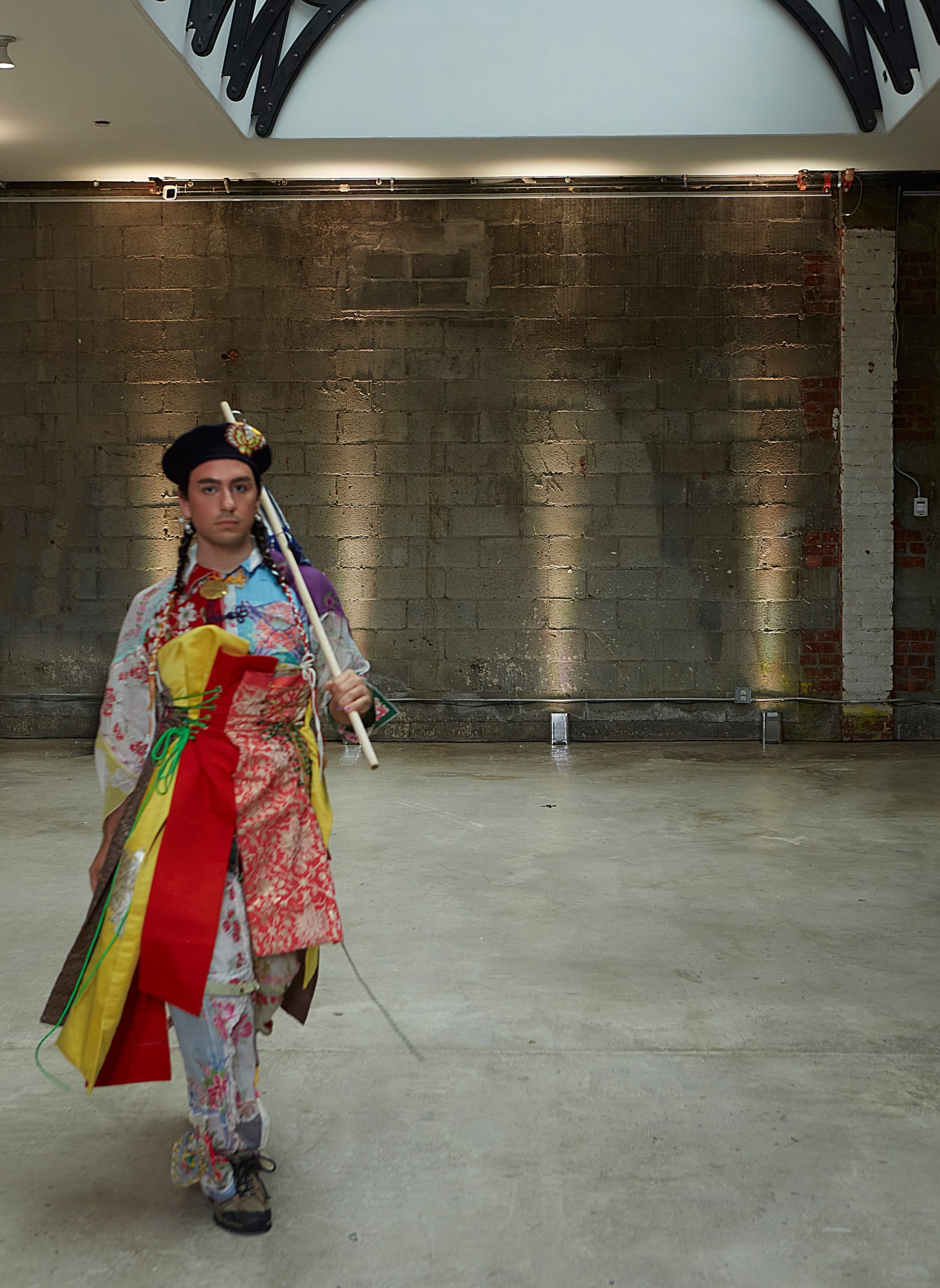
Izzy Kostrzewa
What about your collection excites you most?
It’s all made from waste textiles, damaged Japanese kimonos and obis, military surplus bug nets from Chautauqua county, and even socks and underwear I found in my dorm’s laundry room.
Who do you see wearing it and where?
I see the cool boys like Frank Ocean or Tyler, the Creator wearing them — people who aren’t afraid to be a little queer with their style. They can wear it grocery shopping or getting their mail or at the Teen Choice Awards.
What’s your favorite look and why?
The Rain Jackets because they’re made from tarp cabin covers that are over 50 years old from the summer camp I worked at as a craft house specialist last summer. I have 100 of them in my shed in Michigan.
What’s your biggest aspiration as a designer?
I want to be paving the path for creating a radically sustainable future for clothing and our relationship to it, and I want to still be a fun, free-spirited freak at the end of it.

Amber Qiu
What about your collection excites you most?
The use of laser cutting as a central technique. The process itself guides me, allowing the designs to evolve organically. This approach emphasizes the materiality of each piece and ensures that my collection is not just about the final product, but also about the creative journey and exploration involved in bringing each design to life.
Who do you see wearing it and where?
My collection is designed to be unisex, appealing to anyone with an interest in fashion. I envision individuals who appreciate bold and innovative styles wearing my creations. Personally, I hope NCT members will wear my collection in their music videos.
What’s your favorite look and why?
The second look. It holds a special place in my heart because of the time and effort I invested in designing its intricate repeated pattern. Choosing the perfect fabric with the ideal thickness and sturdiness to effectively showcase the pattern was a challenge. The process of experimenting with various power and speed settings for laser cutting was time-consuming. At the end, all the elements came together in perfect harmony, resulting in an everyday look that exudes a sense of fun and playfulness.
What’s your biggest aspiration as a designer?
I hope that when people pay close attention to the details of my work, they will say ‘wow’. The wow factor is what I strive for, as it signifies that my work has resonated with others on a deeper level. Ultimately, I aspire to gain recognition and have my creations noticed, allowing me to connect with a broader audience and share my passion for design.

Rachel Lee
What about your collection excites you most?
My BFA collection on Korean shamanism and spirituality gave me the opportunity to explore and celebrate the rich cultural heritage and symbolism associated with these practices. Through my collection, I aim to blend traditional elements with contemporary fashion, creating garments that not only showcase the ritualistic nature of Korean shamanism, but also invite a deeper understanding and appreciation of their spiritual significance. I am inspired by all that it embodies, and I’m excited to express those aspects through design and storytelling within my collection.
What’s your favorite look and why?
A fan favorite among my friends is the “Heavenly look.” The crystals serve as a visual representation of the spiritual realm, evoking a sense of divine energy. I love how they create a celestial glow, making the wearer feel connected to the heavens and embodying the mystical essence of Korean shamanistic practices.
What was the most challenging part of creating this collection?
Being a self-produced collection presented its own set of challenges. Throughout the process, there was a constant sense of regret that more could have been accomplished if there had been additional time or hands available.
What’s your biggest aspiration as a designer?
I aspire to relocate to Europe or Asia, where I can pursue opportunities with brands that prioritize craftsmanship, in contrast to the prevailing focus on ready-to-wear fashion in NYC.
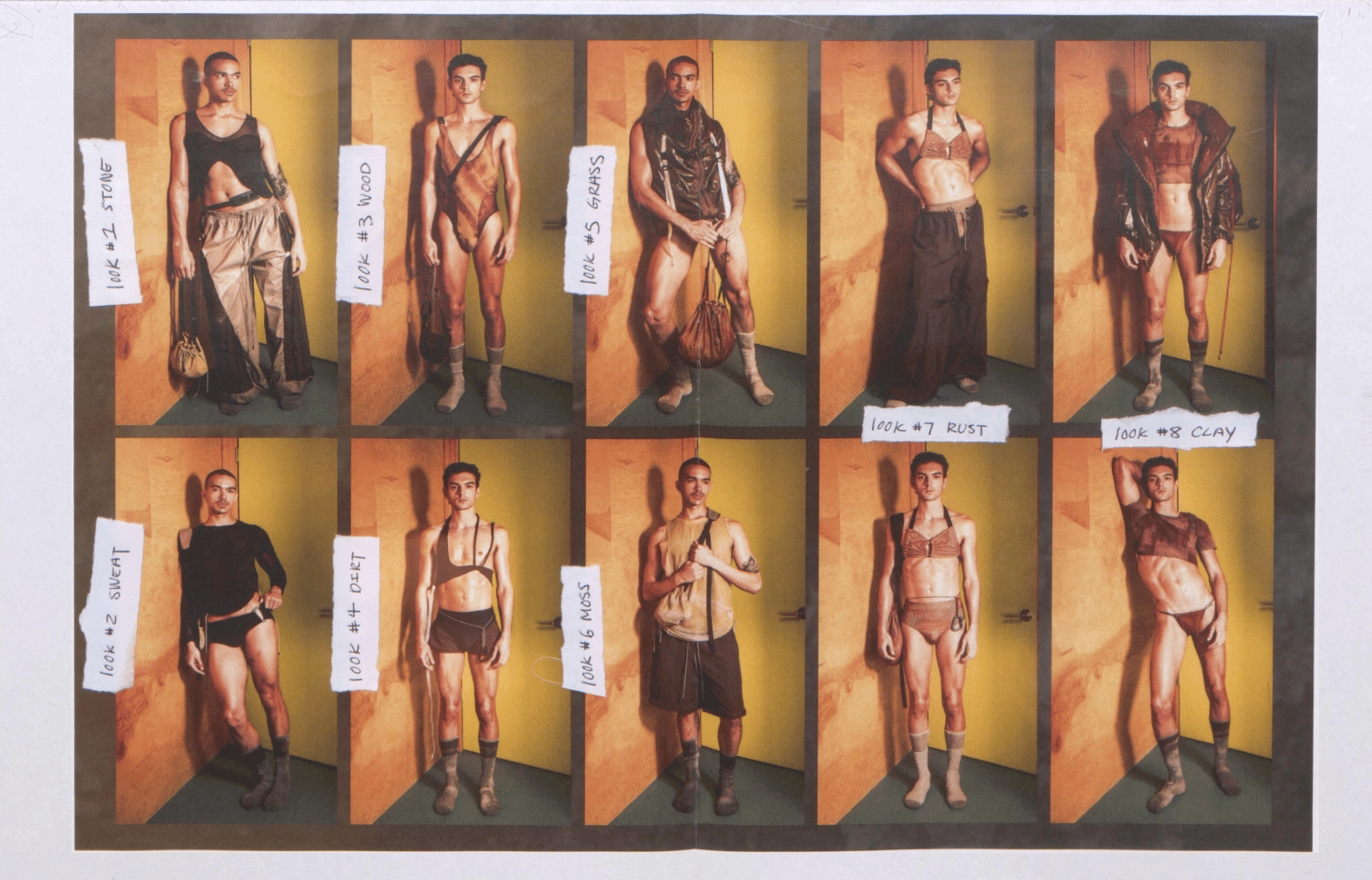
Ethan Gekow
What about your collection excites you most?
The opportunity that this project opened up for collaboration. I worked with a fully gay team (photographers and models) across two different photo shoots. It was important that this collection felt authentic and sexy — a representation of gay lifestyle and full embrace of sexuality. Erotic fantasy meets everyday life here, and that feeling was achieved through collective effort and intrigue. I find that energy extremely exciting.
Who do you see wearing it and where?
I see gays on Fire Island in the carabiner underwear, out at the club in a tiny top, taking a glam hiking trip in the zip off pant, back at home lounging in the track pants, fucking in the camper jockstraps. This collection has a lifestyle feel and capsule wardrobe kind of approach, so I think you’ll find there’s something for every occasion, terrain and situation.
What’s your favorite look and why?
My favorite look is rust. I think this look speaks to the essence of the whole collection. I wanted all pieces to be water/sweatproof and thought it would be hot to have a kind of “male bikini.” The camper pants have a full zip crotch front to back for east access in either direction. There’s a level of humor here, but it’s still super sexy and wearable.
What’s your biggest aspiration as a designer?
I want to offer a product that’s tactical and thoughtful to people who want to feel sexy. I value clothes that are unique and special, but also don’t feel too precious. I think clothing influences the ways we act and feel about ourselves — hopefully I can create clothing and curate imagery that makes people excited to live their lives, and confident enough to do that freely and beautifully.
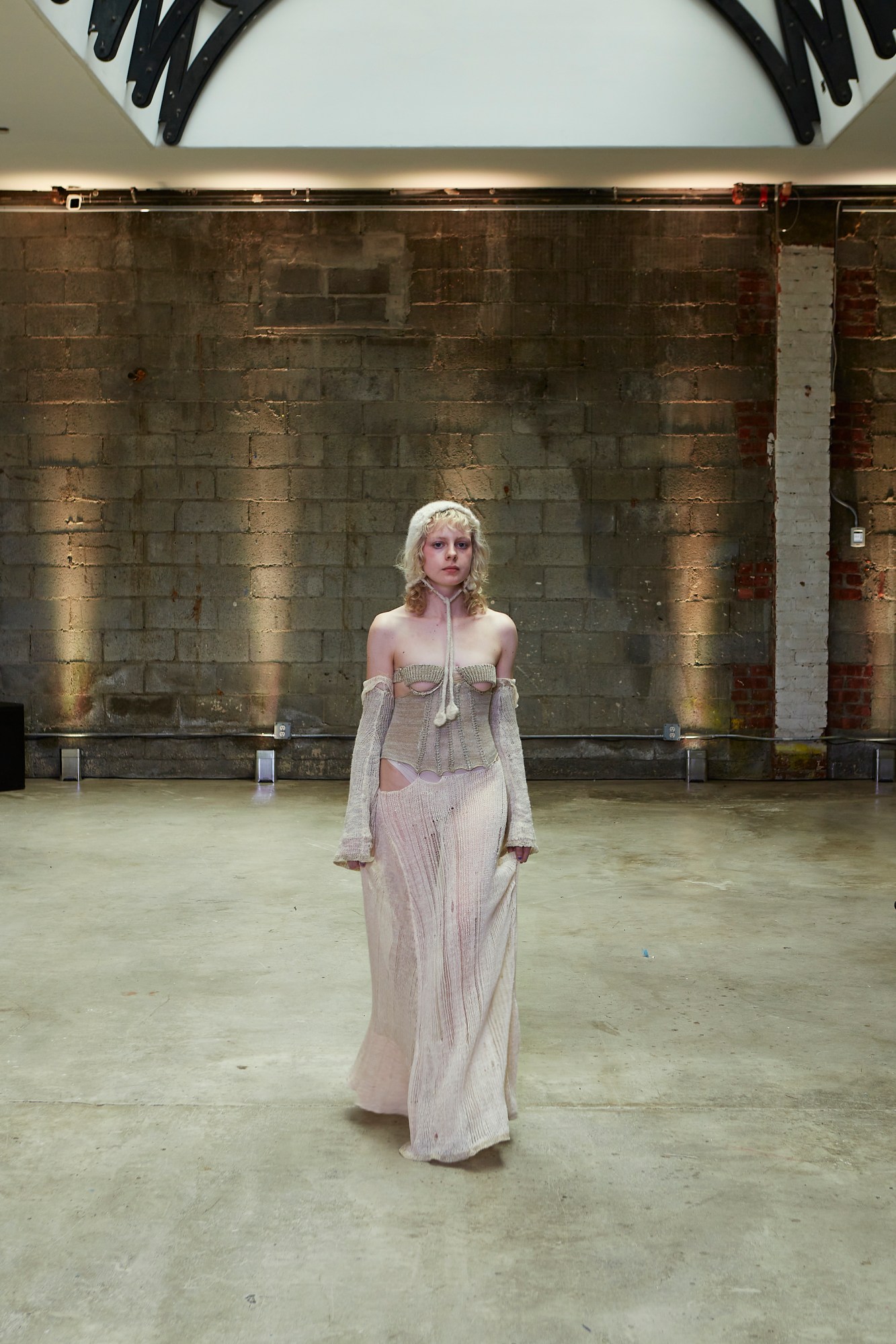
Grace Gordon
What about your collection excites you most?
I’ve been experimenting with language and meaning by encoding text into garments and that process has been the most exciting to me. I employed this concept through my knit pieces in this collection via drop-stitches, eyelets, cable and varying rib manipulations, and I’m planning to push this idea further as I continue making. I feel that it’s the perfect way to tell my story without giving too much away, although I’d love to develop a more decipherable iteration of this knitted textile.
Who do you see wearing it and where?
I imagine the wearer as someone who identifies with my work ideologically: a sentimentalist, a romantic, a realist. It’s partially a capsule collection, so most of the pieces could be styled for any occasion. The pieces are embedded with meaning and meant for wear. Perhaps someone would wear it on a night out, on a coffee date or even while lugging their laundry down the stairs of their walk-up apartment.
What’s your favorite look and why?
My favorite look is the fully fashioned knit gown. It was the most laborious and the most fun to make, as I hand-crafted the silver underwire and developed my own technique for knitting boning casing to create a knitted corset. In my eyes, this look is a transitional portrait of the ultimate sad girl as she becomes a ravaged woman.
What was the most challenging part of creating this collection?
I would say that at the start, the biggest challenge was indecision. Later, it was the labor that my collection required. With the vast majority of my collection being made up of garments that are a combination of woven and knit, there was a lot of trial and error of fit and with proper methods of connection. I am a knitting fundamentalist in that I don’t believe in machine sewing shaped knit pieces, therefore every piece I made had quite a bit of hand work involved.
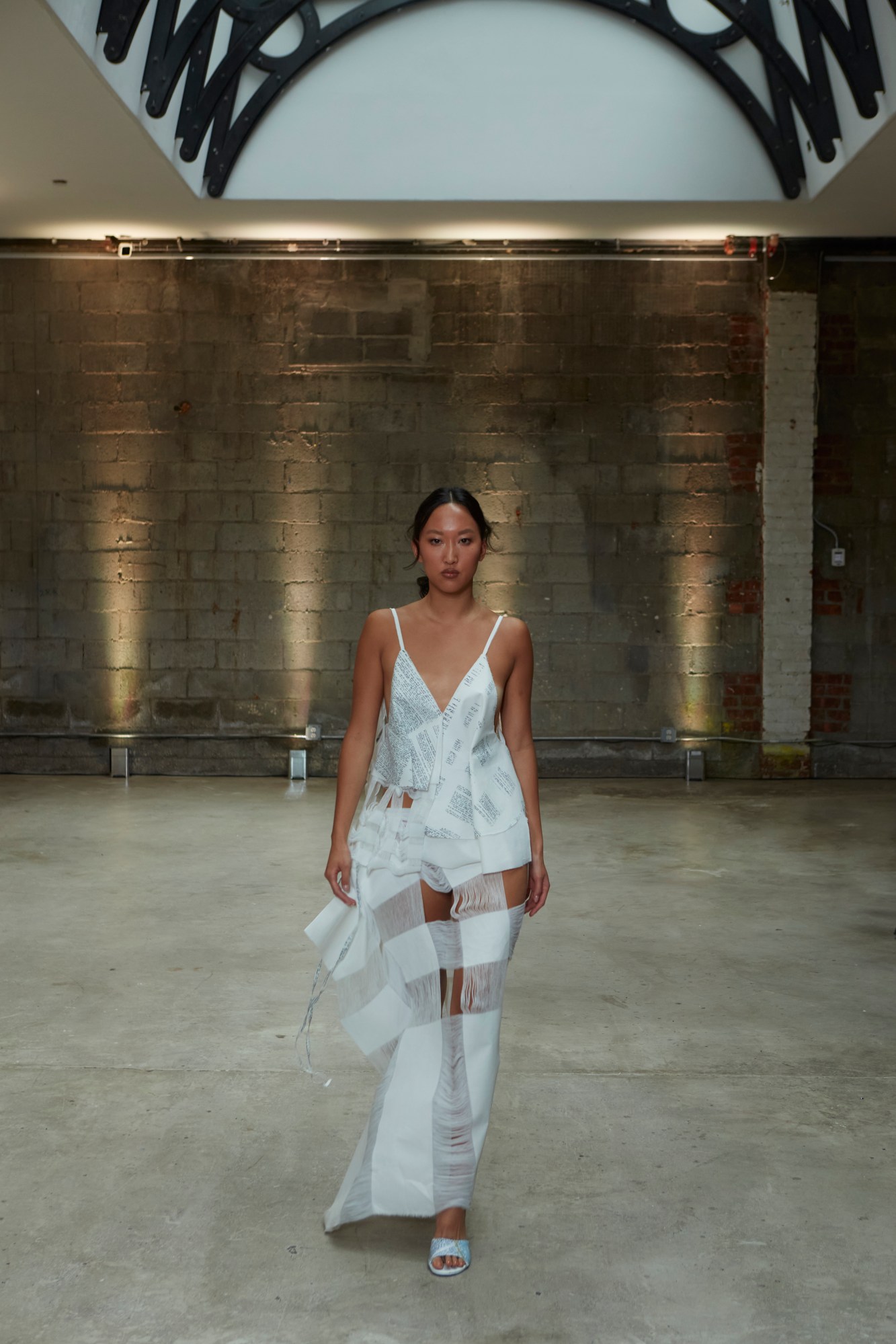
Lillian Chen
What about your collection excites you most?
The version of me that came out from the other side of this collection excites me the most because I feel like once a storyteller learns to tell stories for themselves, they are released from the shackles of needing external validation to create. That freedom makes me excited to see what else I have in store.
Who do you see wearing it and where?
I want whoever is wearing ‘Letters to You’ to know their worth and not let fashion become just another means of allowing others to validate their worth. I want them to feel elegant and beautiful because they already know they are.
What was the most challenging part of creating this collection?
Figuring out how to take something as raw and personal as my journal and finding ways that properly translated the emotional journey was definitely a challenge, but realizing that fraying — the textile manipulation that I had landed on — was making me really allergic to my work was definitely worse.
I also promised myself two years ago that I would stop seeing my worth through my productivity and the validation of others. Creating this collection put this to the test, especially after I had taken two years off from school and was now coming back to the environment that used to be the breeding ground for it. A huge turning point was when I was finally able to allow myself to fully make this collection for me, for the version of myself that could’ve never had fathomed telling her stories no matter if anyone was listening.
What’s your biggest aspiration as a designer?
I want to continue to share my stories in a way that might inspire others. I hope that in the practice of telling these stories for myself, I can help individuals who find themselves hopeless and lost like I once was.
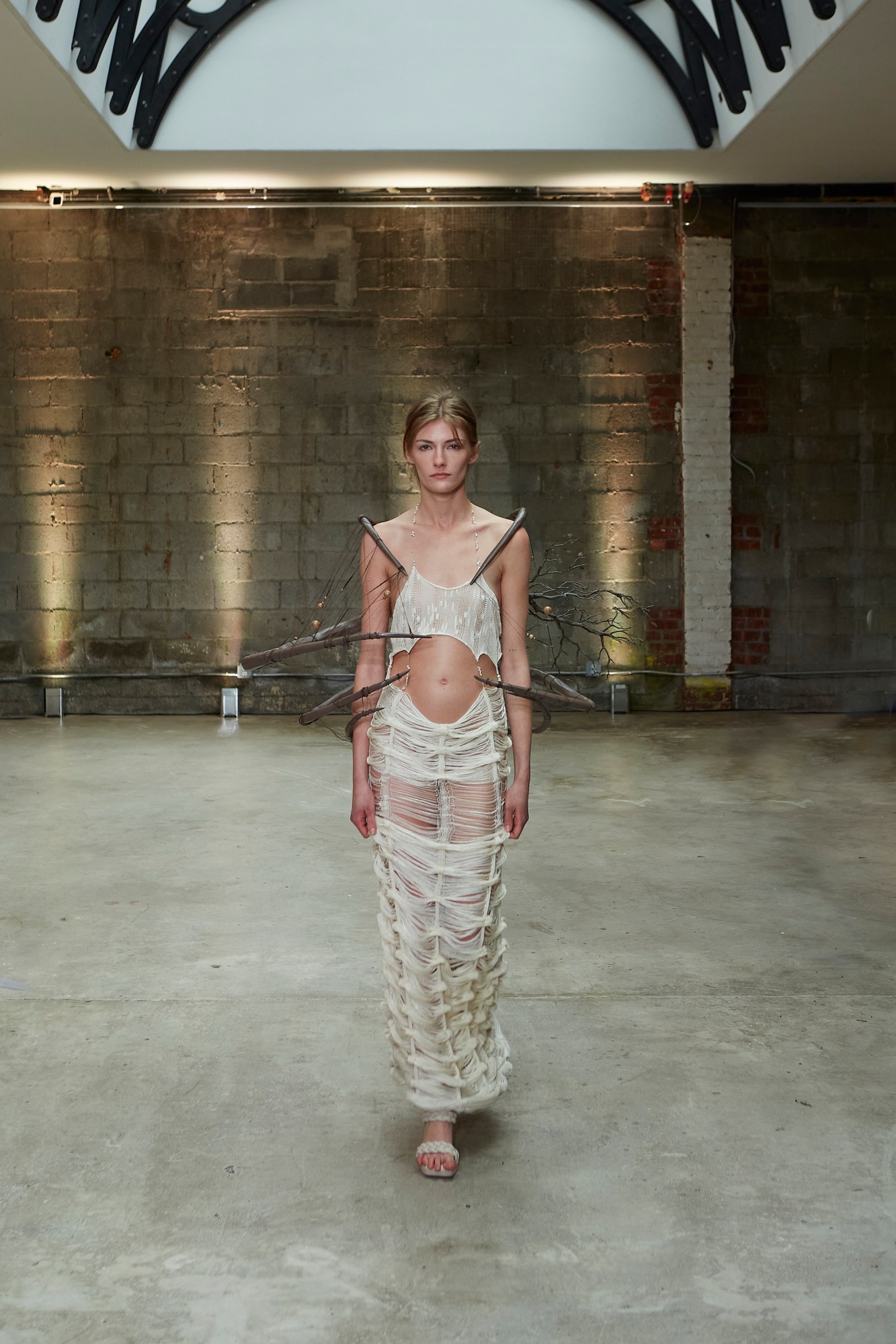
Shushu Chen
What about your collection excites you most?
The idea of celebrating the divinity of the sentient nature. I got inspiration from a romantic meditation I had during my high school time: reading “Walden” by Henry David Thoreau on the side of Walden Pond, which taught me about “sucking out all the marrow of life.”
Who do you see wearing it and where?
Anyone and anywhere.
What’s your favorite look and why?
My favorite look is the brown 3D printed piece with the white knitted dress. It’s about “branches growing out from a human skeleton,” which indicates the idea about harmonious relationship between human beings and nature. The white knitted dress has wave shapes which presents the shape of both water and mountain.
What was the most challenging part of creating this collection?
More and more fashion designers are using machine knitting techniques, so it’s very hard to be unique and have a distinctive personal style, not only for designs but also for branding. In order to emphasize my idea, I used handmade paper which mixed with plant seeds as my brands’ label tags and posters. So, if customers plant and water the label in the soil, there will be flowers blooming out soon.
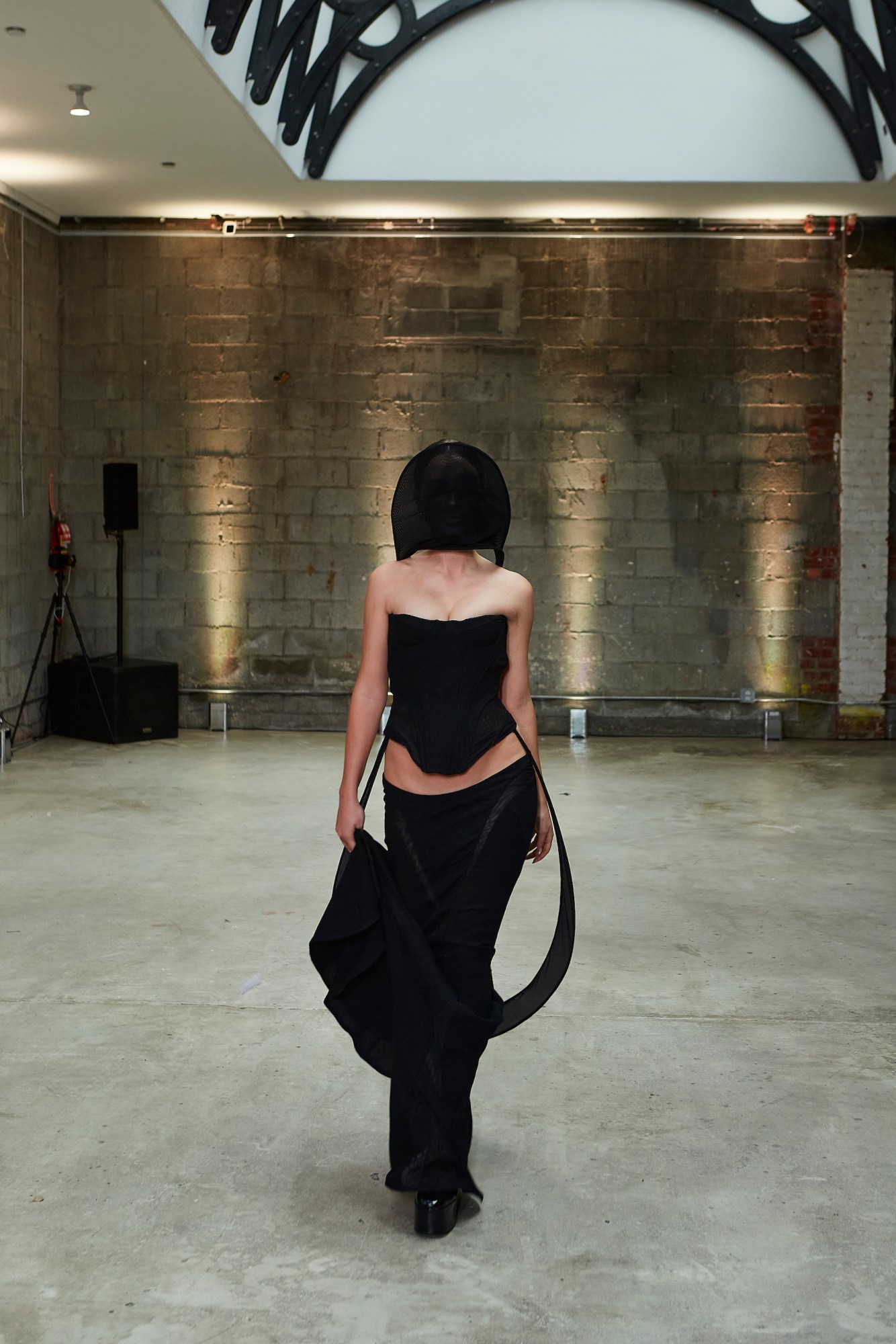
Shirley Tang
What about your collection excites you most?
I’m most excited about the world that I was able to create within and beyond this collection, and the multiple collaborators who fully immersed themselves in, believed, and expanded the storytelling that was behind the designs. As a designer who also owns and runs my own RTW label ORIENS, the idea of commerciality and desirability always plays in the back of my mind, and I’m incredibly grateful and fulfilled by my decision to take this as an opportunity to push my making into sculptural, demi-couture forms, and truly unveil the full fantasy of what my designs could be.
Who do you see wearing it and where?
As much as I see it situated within the space I have created for it, this limbo that is between past and future, cultural but universal, I think the underlying sensuality, futurist desire and reverence to the female form allows it to transform for multiple wearers and contexts. I could see the hooded top and pant looks transforming day to night on streets of New York or Paris, but I’m most excited about the prospect of the triptych of corset looks in a music video, at a premiere or red carpet event.
What’s your favorite look and why?
The corseted looks, which were designed as variations upon each other, and embody different mystic figures within this collection’s world. These looks were the most physically intensive to make, the white one taking hours in the metal shop and culminating to probably 80+ hours of work total, but were the most fulfilling because of my intensely detail oriented and perfectionist nature.
What’s your biggest aspiration as a designer?
For me, it is creating compelling works and stories that connect with and evoke desire from the viewer. I’m excited to expand ORIENS and its storytelling, and have the opportunity to create a space or installation that materializes the world that I’m building and highlight the incredible artists and collaborators that supported this vision, but long term I’m also very interested in luxury houses being revived and helmed by young creatives.

Marcelle Barbosa
What about your collection excites you most?
What excites me the most about my collection, titled ‘Game of Chance,’ is the concept itself. The collection draws parallels between the US immigration system and childhood board games (like Monopoly and Where’s Waldo), which are a lot more alike than we think.
What’s your favorite look and why?
The Basic Look and the hero piece of the collection would be my favorite. The white graphic tee, sculpted from children’s putty (foam clay), and the pannier denim skirt embody what I want to continue to create as a designer: pieces that explore unconventional mediums and techniques within traditional garments. I also had the opportunity to collaborate with Amethyst Monet to develop and hand paint the graphic on the tee, which helped bring the piece and concept to life.
What was the most challenging part of creating this collection?
The most challenging part (not considering the very long nights, tight budget, short deadlines, daily trips to Midtown, dubious mental health and many trashed samples) was finding the right balance between wearability and creating a statement piece.
What’s your biggest aspiration as a designer?
My biggest aspiration is to explore and integrate techniques from industries outside of fashion in the construction of garments, ultimately bringing a different perspective and alternatives to wearable fashion.
Credits
All photos courtesy of Joseph Jagos
